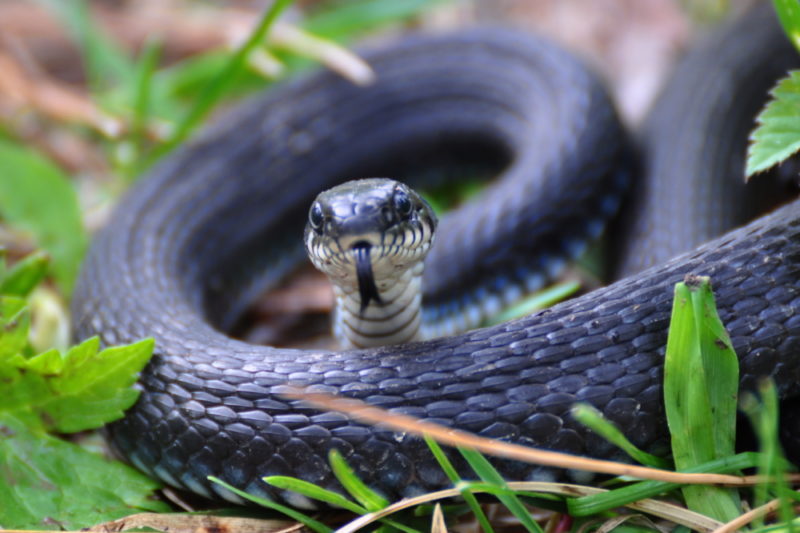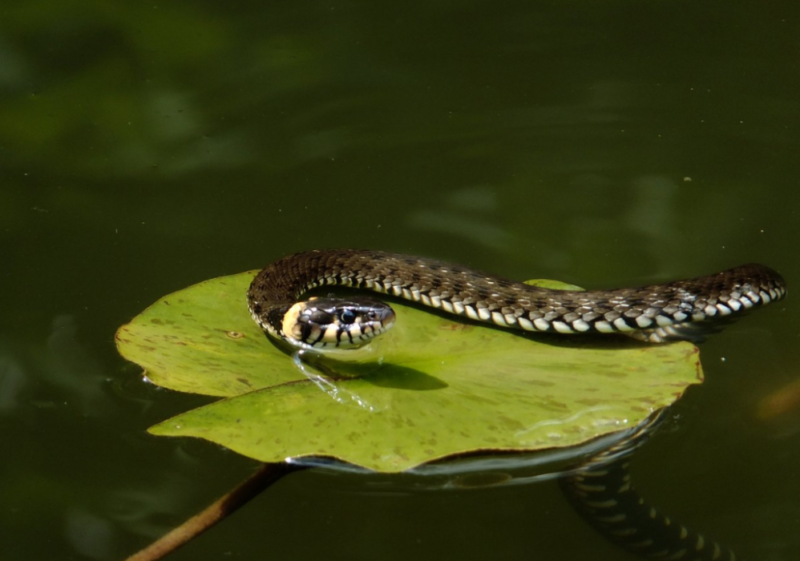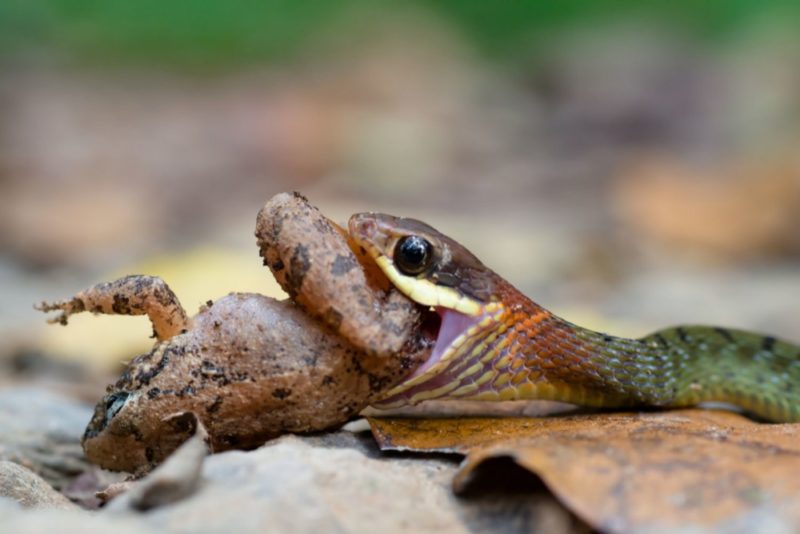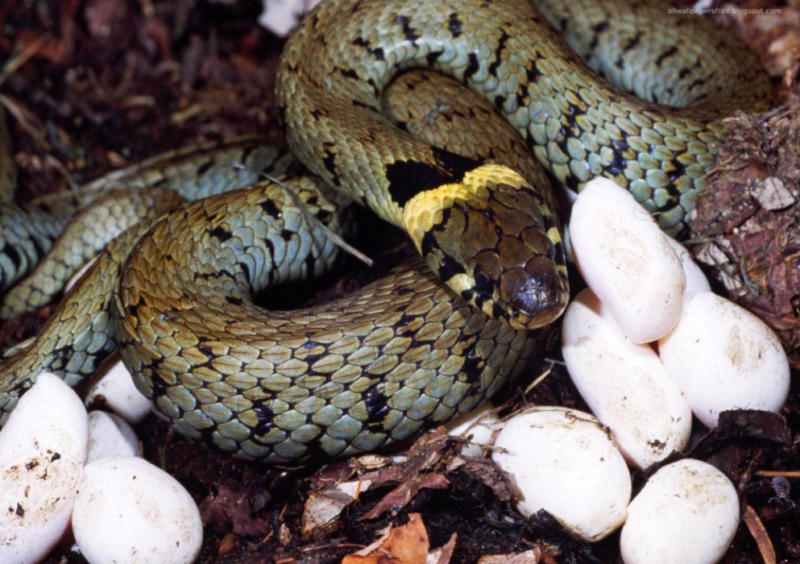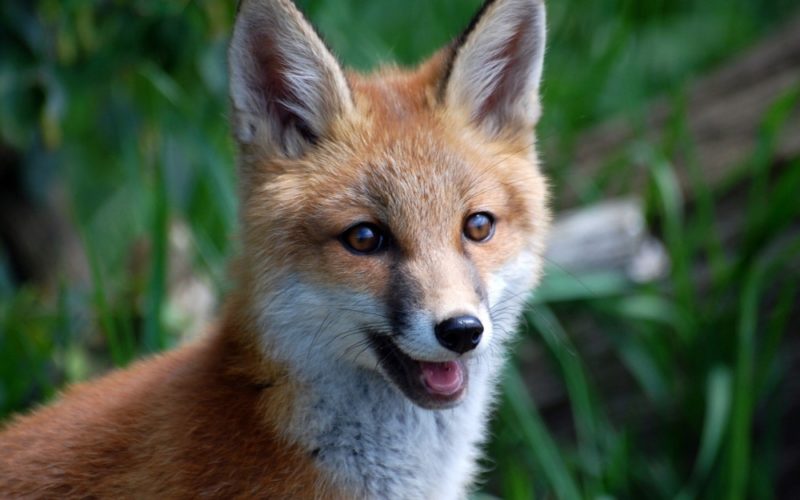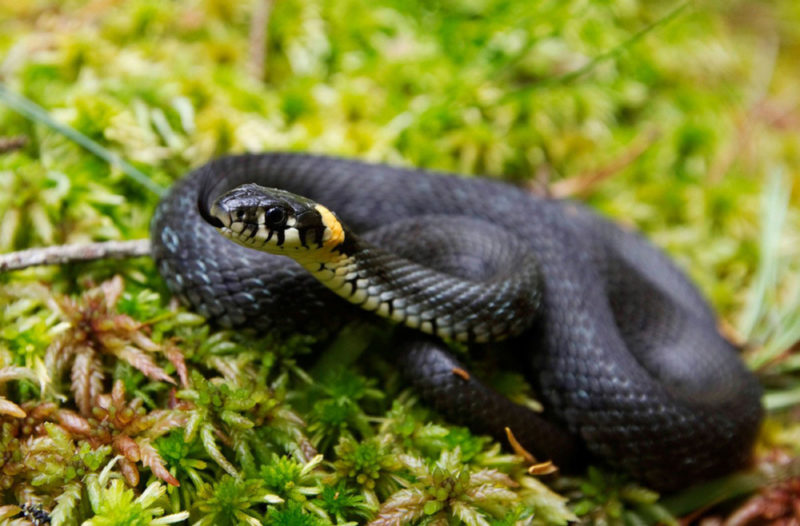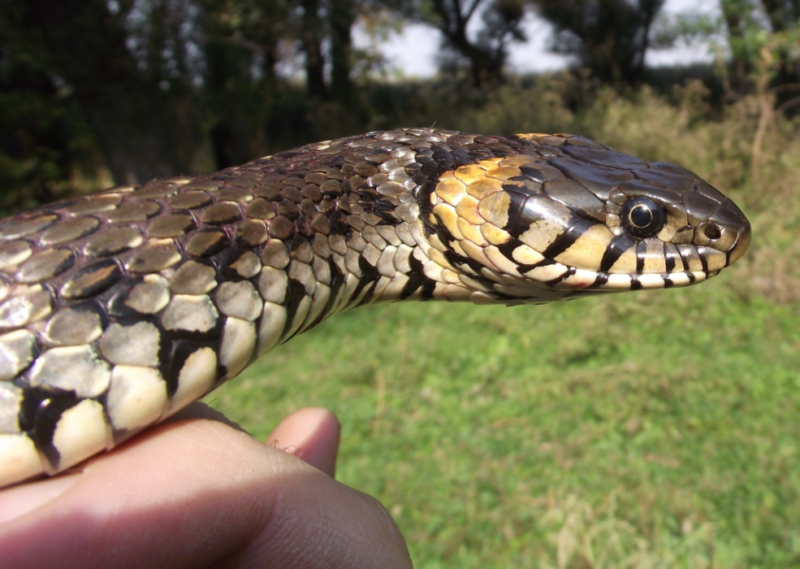Already an ordinary member of the family is already distinctive, to which two-thirds of snakes on the planet belong. A peaceful, vicious reptile does no harm, but people out of ignorance confuse it with a poisonous viper, they are in vain afraid and unjustly destroyed.
Material Content:
Features and habitat
The description of the species will help to know the snake by external signs, distinguish it from poisonous snakes:
- The body length of females is 0.5–1.5 m, males - up to 80 cm. Occasionally individuals come across more than 2 meters.
- The head is oval, ovoid, distinctly separated from the body. Two bright symmetrical marks of yellow-orange or white color lie at the base, this is the main difference from the viper.
- The head is covered with large symmetrical shields of the correct form.
- In the mouth are small teeth, a long forked tongue.
- The eyes are large, slightly convex, the pupils are black and round, in the viper they are vertical.
- The color varies depending on the habitat of the snake. The upper part is covered with scales of black, gray-brown, dark green, brown, abdomen of a light gray or off-white hue. Dark spots appear in the form of dashed lines against the background of the base color.
- The body smoothly passes into a thin tail; it is 3-5 times shorter than the body.
The range of snakes includes the European territory of Eurasia to the Arctic Circle, the southern and western regions of Siberia, the northern regions of Asia Minor and Africa. They settle at reservoirs: rivers, lakes, streams, ponds. Mass accumulations are noticed in wet areas of land: in bushes, in meadows, forest glades.Often snakes are found in forest park areas, on embankments in the city limits, abandoned farm buildings, basements of village houses, in gardens, kitchen gardens, and personal plots.
Character and lifestyle
Uzh - non-aggressive, balanced reptiles, when meeting with a person retire, do not attack first.
When they cannot escape, they flatten and raise their heads, hiss menacingly, imitating an adder. With close contact, they sometimes bite, but leave only harmless scratches on the skin. Enthusiasts keep them in a terrarium and look after them like pets.
In the warm season, reptiles lead a mobile lifestyle: they hunt, mate and breed. With sunrise, they become more active, like to swim, more often along the shore. In clear weather, bask in the sun on tree trunks, elevations. By dusk they hide in shelters: voids among the roots of trees, in piles of stones, old rodent burrows. From spring to autumn, reptiles 3-4 molt: they make their way into narrow crevices to turn out and discard the old skin.
Representatives of the species quickly crawl, easily climb trees, deftly move in the water and dive. During the swims they wriggle with a flexible body, their head is kept above the surface. It is no coincidence that in the scientific world the species was given the name Natrix natrix, the name comes from the Latin natans - in translation "swimmer".
In the cold season, snakes hibernate, the numbness lasts 5-8 months, depending on the climate. For the winter they climb into the hollows of trees, abandoned burrows of mammals, earthen cracks. Sometimes in places protected from the cold, where the temperature is above zero, dozens of individuals gather.
Nutrition
Reptiles do not eat plants and carrion, amphibians, fish, less often birds and small rodents become food for them.
Here is what the ordinary eats:
- newts;
- tadpoles;
- tree frogs;
- salamanders;
- lizards;
- common toads;
- chicks that have fallen from the nest, bird eggs;
- medium-sized rodents: water rats, mice;
- small fish, fry;
- insect larvae.
He knows how to stretch his mouth and throat and swallows the whole production, then pushes it inside. The teeth are not suitable for tearing and chewing food. In the water, it freezes and waits when the prey swims closer, then grabs with a swift movement. A small fish is swallowed instantly, a large one is carried ashore.
On land, the snake pursues prey, easily catches up with frogs and lizards. Due to the victim’s resistance, swallowing sometimes stretches for hours. After a hearty feed, the reptile goes without food for a week and does not hunt. In terrariums, they drink milk without any harm to their health, although this product is contraindicated for other snakes.
Reproduction of a non-toxic snake
Snakes become sexually mature at 3-5 years old, from this moment they are ready to mate, reproduce offspring. Matrimonial games begin in the spring with the arrival of heat, the specific time depends on the region. The beginning of the season of snake weddings coincides with the end of spring molting. Reptiles crawl out of the old skin when they catch and digest the first prey after wintering.
Before mating, the males shake their heads, touch their partner's jaws, then the reptiles weave into a mating ball, sometimes more than 2 dozen individuals gather in it. Since mid-summer, the female has been looking for a warm, moist place where she lays up to 30 eggs. Raw moss, lots of foliage or hay, dung, compost heaps, and wood dust become the “incubator”. Then the masonry is left unattended: the female does not hatch and does not protect eggs.
After 1.5–2 months, snakes 11–18 cm in size appear. From birth, they are ready for independent life, before the onset of cold weather they are looking for winter hibernation and prey for feeding. If food cannot be found, the ozhata survive well until spring, but develop more slowly than their well-fed counterparts. Sometimes snakes mate in the fall, and oviposition is carried over to spring.
Life span
In the wild, snakes live from 19 to 23 years.The main condition for a successful long life is the presence of a reservoir and natural shelters. Premature death occurs when meeting with predators, but the reptile has learned to defend itself. At the moment of danger, she secretes a secret with a pungent repulsive odor. If this method does not help, it pretends to be dead: twitches in convulsions, then completely relaxes, does not respond to external stimuli, opens its mouth, dumping a motionless tongue. The predator throws the carrion, and the reptile calmly creeps away. In the terrarium, the life span remains the same as in natural conditions.
Natural enemies
Dangerous time comes at night, if you do not have time to hide in shelter. After sunset, the body cools quickly, loses its mobility, so it will not be able to hide from potential enemies.
In the natural environment, snakes are hunted by:
- predatory mammals: foxes, badgers, weasels, hedgehogs;
- rodents, including rats;
- birds: storks, gray herons;
- large fish and toads pursue young growth;
- ants destroy eggs.
They suffer because of the distant external resemblance to a viper: people mistakenly take them for poisonous dangerous snakes and destroy harmless reptiles.
Interesting Facts
Curious information is known about snakes:
- Until the 20th century, villagers firmly believed: to kill a snake - to bring trouble into a house. Poisonous reptiles were not offended, so they calmly settled in peasant households.
- Among Natrix, melanists are occasionally born - completely black individuals and albinos - pinkish-white with red pupils.
- Snakes can do without food for months. The German naturalist conducted an experiment: he did not give ward food for 10 months, from early summer to April. The first feeding after a hunger strike did not cause any disturbances in the gastrointestinal tract.
- If there is not enough shelter suitable for laying, the females arrange a joint storage. Eyewitnesses found on the lawn under the old rotten door 1,2 thousand eggs laid in layers.
- Floating snakes were noticed dozens of kilometers from the shores of large lakes, once recorded in the Bay of Biscay, 40 km from land.
- Reptiles calmly do without air under water for up to half an hour. During hunting or in extreme heat, they sometimes sink to the bottom, underwater snags and relax.
In Russia, Belarus and Ukraine, non-toxic snakes were kept in rural households to catch and scare mice. Reptiles coped no worse than cats.
The protection and protection of the common snake
The species Natrix natrix is not threatened with extinction, but in some regions the population has been greatly reduced. Representatives of the species are listed in the Red Book of Moscow, Leningrad Region, Karelia. The main reasons for the decline in the population are deforestation, land reclamation, drying out of ponds, and improvement of river valleys. Human actions lead to a reduction in habitable area, egg laying, wintering, and reptile hunting.
In the regions, programs are being developed to restore the population in protected areas - specially protected natural areas. Near-water flora is recreated on the banks of the rivers; mass recreation is allowed only in specially designated areas.
In the countries of the European Union, Natrix was put on the Red List. Ecologists are landscaping ponds for hunting reptiles, creating places for oviposition, forbidding to destroy and catch snakes for keeping in home terrariums.


